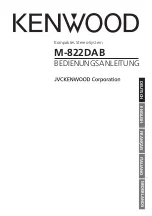
LO LEVEL
This control determines the output (volume) level for the LO Mode when it is active. Like HI LEVEL, it allows for relative volume
levels of the LO Mode above or below that of the HI Mode. Use LO LEVEL to set the signal strength of the LO Mode in relation to the BYPASS
Mode. Like the HI LEVEL, LO LEVEL may also be used to “slam” the Input stage of the host amplifier for more overdrive.
NOTE: Separate HI LEVEL and LO LEVEL controls were included to allow for compensation of volume levels between the two Modes (HI/LO)
when one Mode is being used with the Five Band Graphic EQ and the other Mode is not. This allows for maximum flexibility and permits a
radically EQ’d sound in one Mode (HI for example) to be matched level-wise to a sound without the Graphic EQ active in the other Mode (LO).
TONE
This all-in-one EQ control is common on devices that do not incorporate individual TREBLE and BASS controls. It provides simple,
global adjustment of the entire range of frequencies with one control, but your ear may perceive it as most active on the amount of high frequen-
cies present in the mix. A setting of 12:00 represents a “flat” setting with highs neither boosted nor cut. Increasing the TONE control past 12:00
boosts a broad band of high frequencies. Decreasing the TONE below 12:00 cuts (rolls off) the same spectrum of high frequencies.
GAIN
This control determines the amount of gain (overdrive) in the signal path for both LO and HI Modes.
Set low (8:00 – 10:30) it produces a range of subtle overdrive that’s soft and furry, yet featuring the classic mid-punch associated with these
types of circuits. In the LO Mode this range is great for pushed and clip-threshold rhythm sounds and to add a slight bump for Blues solo sounds.
The middle range (10:30 – 1:30) offers the most useful region of gain that begins to saturate but still retains a dynamic punch that keeps notes
expressive and tight. This works well for both Rhythm and Solo work across many styles of music where medium levels of saturation are ap-
propriate in both Modes.
The high range of the GAIN control (1:30 – 5:30) is all about thick saturation. This region will be the obvious choice for extreme Rock, Metal and
Heavy styles yet should not be overlooked for searing sustain in single-note soloing. Don’t forget to experiment with this region for some great
Rock Solo sounds in the LO Mode as well.
MID CUT
In addition to the standard “blend-type” TONE control, the THROTTLE BOX EQ incorporates a global (works in LO and HI Modes)
MID CUT control (located just below the HI LEVEL) that scoops out the midrange for a wider, bigger sound. It can also be used to mimic the
classic Boogie “V” GRAPHIC EQ curve. This has been an essential ingredient for the many Artists that have employed this powerful tool on
our amplifiers for decades to get some of the heaviest sounds around. This control works backwards from what you might be used to with Tone
controls. As you increase the control you are increasing the “cut” and scooping out more midrange frequencies—until at the maximum setting
(5:30) there is hardly any midrange left in the signal path.
FIVE BAND GRAPHIC EQ
These two mini toggle switches, two LEDs and the five Sliders comprise the GRAPHIC EQ section of the THROT-
TLE BOX EQ™. The two mini toggles control whether or not the GRAPHIC EQ is active in HI, LO or both. The Red LED is illuminated when the
EQ is active in the corresponding Mode. The curved bar just below the Sliders is fitted to help protect the Sliders and prevent accidental bumping
of them by the stray shoe in performance situations.
Содержание Throttle Box
Страница 1: ...Owner s Manual...
Страница 12: ...14 04 01...






























